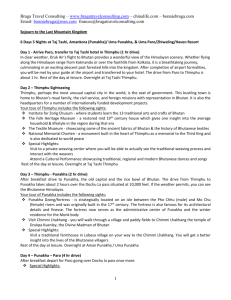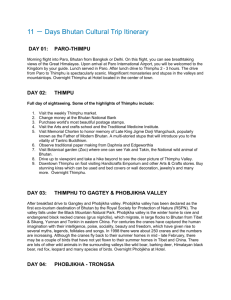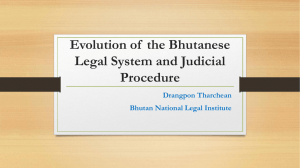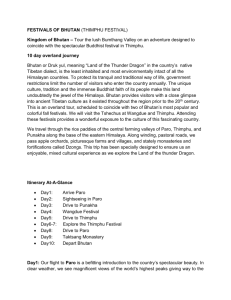Central Bhutan: 08 Nights Tashi Tours & Travels The Hidden
advertisement
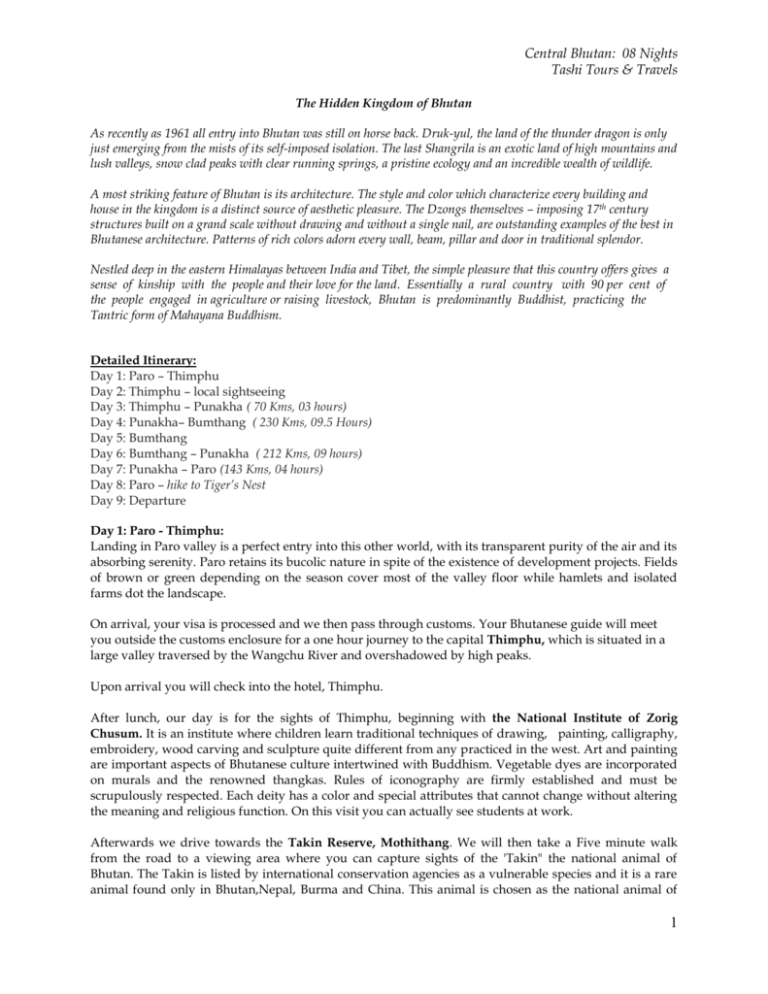
Central Bhutan: 08 Nights Tashi Tours & Travels The Hidden Kingdom of Bhutan As recently as 1961 all entry into Bhutan was still on horse back. Druk-yul, the land of the thunder dragon is only just emerging from the mists of its self-imposed isolation. The last Shangrila is an exotic land of high mountains and lush valleys, snow clad peaks with clear running springs, a pristine ecology and an incredible wealth of wildlife. A most striking feature of Bhutan is its architecture. The style and color which characterize every building and house in the kingdom is a distinct source of aesthetic pleasure. The Dzongs themselves – imposing 17th century structures built on a grand scale without drawing and without a single nail, are outstanding examples of the best in Bhutanese architecture. Patterns of rich colors adorn every wall, beam, pillar and door in traditional splendor. Nestled deep in the eastern Himalayas between India and Tibet, the simple pleasure that this country offers gives a sense of kinship with the people and their love for the land. Essentially a rural country with 90 per cent of the people engaged in agriculture or raising livestock, Bhutan is predominantly Buddhist, practicing the Tantric form of Mahayana Buddhism. Detailed Itinerary: Day 1: Paro – Thimphu Day 2: Thimphu – local sightseeing Day 3: Thimphu – Punakha ( 70 Kms, 03 hours) Day 4: Punakha– Bumthang ( 230 Kms, 09.5 Hours) Day 5: Bumthang Day 6: Bumthang – Punakha ( 212 Kms, 09 hours) Day 7: Punakha – Paro (143 Kms, 04 hours) Day 8: Paro – hike to Tiger’s Nest Day 9: Departure Day 1: Paro - Thimphu: Landing in Paro valley is a perfect entry into this other world, with its transparent purity of the air and its absorbing serenity. Paro retains its bucolic nature in spite of the existence of development projects. Fields of brown or green depending on the season cover most of the valley floor while hamlets and isolated farms dot the landscape. On arrival, your visa is processed and we then pass through customs. Your Bhutanese guide will meet you outside the customs enclosure for a one hour journey to the capital Thimphu, which is situated in a large valley traversed by the Wangchu River and overshadowed by high peaks. Upon arrival you will check into the hotel, Thimphu. After lunch, our day is for the sights of Thimphu, beginning with the National Institute of Zorig Chusum. It is an institute where children learn traditional techniques of drawing, painting, calligraphy, embroidery, wood carving and sculpture quite different from any practiced in the west. Art and painting are important aspects of Bhutanese culture intertwined with Buddhism. Vegetable dyes are incorporated on murals and the renowned thangkas. Rules of iconography are firmly established and must be scrupulously respected. Each deity has a color and special attributes that cannot change without altering the meaning and religious function. On this visit you can actually see students at work. Afterwards we drive towards the Takin Reserve, Mothithang. We will then take a Five minute walk from the road to a viewing area where you can capture sights of the 'Takin" the national animal of Bhutan. The Takin is listed by international conservation agencies as a vulnerable species and it is a rare animal found only in Bhutan,Nepal, Burma and China. This animal is chosen as the national animal of 1 Central Bhutan: 08 Nights Tashi Tours & Travels Bhutan for its unqiqueness and it association with the country’s national religious history and mythology. If you are lucky, you can also sight a few sambar and barking deer at the reserve area. As evening falls we will visit the Trashichhodzong, the beautiful medieval fortress /monastery is Bhutan’s administrative and religious centre which houses most of the Government's office and the King's Throne Room. It is also the summer residence of Je - Khenpo, the Chief Abbot. The National Assembly hall is located in a new building across the river. This will bring us to the end of our sightseeing in Thimphu for today. Dinner & Overnight at the hotel, Thimphu. Day 2: Thimphu – local sightseeing: We begin our day with a visit to the Memorial Chorten, with its golden spires shining in the sun, its tinkling bells and an endless procession of elderly people circling around it. Erected by the royal grandmother, Ashi Phutsho Choedren in memory of her son the third king Jigme Dorje Wangchuck, it contains a fine collection of Buddhist statues and is a center of tantric Buddhism in all its complexity. Visit the Folk Heritage Museum, founded by Her Majesty the Queen Ashi Dorji Wangchuck. The museum is dedicated to connecting people to the Bhutanese rural past through an exhibition of items and artifacts used in rural households, demonstrating customs, traditions, habits and skills. The principal exhibit is the museum building itself which is a restored threestorey traditional rammed mud and timber house. It contains household objects, typical domestic tools and equipment used by a rural family. You will have an opportunity to witness locals preparing local dishes, giving you an insight to the Bhutanese way of cooking. Paper Factory: The handmade paper making in Bhutan stemmed from the age old tradition originated in 8th century of Bhutanese history. The handmade paper constitutes as valuable National heritage of Bhutanese cultural identity and is preserved through all the ages. The Traditional paper is recognized and held high esteem both in home and outside world. Next, visit the Drupthop Lhakhang Nunnery one of the few surviving nunneries in Bhutan. It was founded in 1976 by Rikey Jadrel, who is considered as emanation of Thangthong Gyalpo (1363 – 1485), the builder of numerous iron chain bridges across the Himalayas. Thang Thong Gyalpo often referred to as The King of the open field. In the early 15th century with his multiple talents he popularly became the Leonardo Da Vinci of the Great Himalayas. The place also has a great view of the majestic, Tashi Chhoe Dzong (Fortress of Glorious Religion) and government cottages nearby. A golf course spans much of the district flanking the lower eastern part. 2 Central Bhutan: 08 Nights Tashi Tours & Travels Onward, we will visit Kuensel Phodrang, where the Buddha Dordena resides, it is said to be one of the largest Buddha in the world, standing at 169 feet / 51.5 meters. You will see Thimphu city from a bird’s eye view. This evening, enjoy a walk up and down the high street lined with little shops of all descriptions. There is always a colorful gathering passing from ubiquitous monk bodies to Bhutanese businessmen, to nomadic farmers that come to trade supplies. You can also visit the newly opened Craft Bazaar, which is the Royal Government of Bhutan’s initiative to promote local craftsmanship, these stalls carry only Bhutanese authentic arts and crafts. Dinner & Overnight at the hotel, Thimphu. Day 3: Thimphu – Punakha: ( 77 Kms, 03 hours) After an early breakfast, we will drive towards Wangdiphiodrang. Enroute we will visit the Simthokha Dzong, the oldest fortress built in 1629 by Shabdrung Ngawang Namgyal (the man who unified Bhutan). The fortress serves as an administrative center, and the center for the monk’s religious activity. The fortress now houses a language school, where scholars study both Dzongkha (the national language) and the English. Leaving Simthokha/ Thimphu, we continue into the countryside towards the Punakha valley, the winter capital of Bhutan. The drive ascends gradually to the Dochula pass over 10300 ft, with magnificent vistas of the Himalayan range. The Dochula Monastery also known as the Druk Wangyal Khangzang Chortens is a tribute to the service and leadership of His Majesty the king. The design inspired by the Queen is a unique cluster of 108 Chortens seen from all directions. The descent to Punakha is vibrant and colorful, with the fluttering prayer flags adding to a rich topography dotted by terrace farming and rivers flowing through. Later, we traverse the Punakha countryside walking through paddy fields to the Pana Village to see the `Chimi Lhakhang’ built by the great Lama Drukpa Kinley in 1400 to subdue local demons. The temple is a popular pilgrimage point for all Bhutanese and is specially revered by women for its fertility powers. The Chimi Lhakhang, situated on a hillock in the centre of the valley, is dedicated to Lama Drukpa Kuenley, who in the late 15th century used humor, songs and outrageous behavior to dramatize his teachings and due to this also known as "Divine Madman". This temple is also known as the temple of fertility. It is widely believed that couples who do not have children and wanting one, if they pray at this temple, they are usually blessed with a child very soon. It is about 30 minute walk across field from the road to the temple. The trail leads across rice fields to the tiny settlement of Pana, meaning "field". It then follows a tiny stream downhill to Yoaka and across more fields before making a short climb to Chimi Lhakhang. After lunch, we will visit the historic Punakha Dzong sprawled at the confluence of the Phochu (male) and Mochu (female) rivers. It was built by Shabdrung Nawang in 1637 and serves as the winter residence of the head abbot, Je Khenpo and headquarters of the district administration. In the late afternoon we will drive back to the hotel in Wangduephodrang. Evening at leisure, since we have a long drive to Bumthang tomorrow. Dinner & Overnight at the hotel, Punakha. Day 4: Punakha – Bumthang ( 230 Kms, 09 Hours): 3 Central Bhutan: 08 Nights Tashi Tours & Travels Early morning, continue your journey to central Bhutan. We will drive towards Trongsa crossing 3,300m high Pele la pass. As we descend from the pass through the dwarf bamboo we reach at Chendebji Chorten. This Chorten or Stupa was built in 18th century by a Lama known as Shida, in order to nail into the ground a demon that had been terrorizing the inhabitants of this valley and the Ada valley just over the ridge. We will also oftentimes encounter yaks on the way. Continue your drive to Trongsa, as you enter Trongsa valley, the huge fortress of Trongsa dominates the entire landscape. No wonder, it is the largest Dzong/fortress in the country. Like all other Dzongs, it has been built on a strategic location. The view from the Dzong extends for many miles and in ancient times nothing could escape the vigilance of its watchmen. The route to Bumthang crosses Pele La Pass at 3,400 m (11,155 ft), marked by a chorten and an array of prayer flags. View the dramatic Jhomolhari Mountain (7,219 m / 23,684 ft) and other peaks, which mark the boundary between western and central Bhutan. Beyond Pele La Pass is Longte Valley and this is a great opportunity for yak spotting. Arrive Bumthang early evening, check into the hotel and have the evening at leisure after the long drive to Bumthang. Dinner & Overnight at the hotel, Bumthang. Day 5: Bumthang : The sightseeing today will be followed in the style of Bhutanese tradition, which is in clock wise direction. Your car will drop you at the Kurjey Lhakhang, one of the holiest temples in the country. It is believed that in the eighth century Guru Padmasambhava had meditated here and subdued the local deity known as Shelging Karpo. Begin your hike from here crossing the suspension bridge and visit Padmasambhava Lhakhang. This is another meditation site of Guru Padmasambhava. It was founded by Terton (treasure seeker) Pema Lingpa in 15th century and was restored by the Grand Queen Mother of present King. Bumthang valley is truly the most sacred place in Bhutan. Continue your hike to Tamshing Lhakhang, founded in early 16th century by Terton Pema Lingpa. Next, you will visit Konchogsum Lhakhang, built in the 8th century. The Temple is famous for its bell, which bears an inscription from the eighth century. Your car will pick you up from here. Dinner & Overnight at the hotel, Bumthang. Day 6: Bumthang – Punakha: Early morning we begin our journey back to the central region of the country. Early evening, we will check into the hotel and the evening is at leisure. Dinner & Overnight at the hotel, Punakha. Day 7: Punakha – Paro: After an early breakfast we will drive towards Paro. Visit the National Museum, located in Paro Dzong’s 17th-century watchtower. The building itself boasts an unusual shape said to resemble a conch shell. NOTE: During the September, 2010 earthquake there was severe damages to the main building of the museum. Because of which the main building is closed to visitors however objects and artifacts have been moved to a new wing, just above the main building where visistors are allowed to visit. See a fine collection of old thangka paintings and textiles, ancient weapons, and Bhutanese artifacts. The museum, by the way, is considered a temple due to the religious objects it houses, and as such we are asked to remove our shoes and to move inside in a clockwise direction. Visit the Paro Dzong, also called Rinpung Dzong, the Fortress of a Heap of Jewels. Constructed in the early 15th century as a diminutive fort, it was presented to the religious and political authority of Shabdrung Ngarvang, who developed it into a much more commanding fortress in 1646. This is without doubt one of the kingdom’s finest examples of traditional Bhutanese architecture. Once, great catapults here flung stones at invading Tibetans. Today the dzong houses a monastic school. Two hundred resident 4 Central Bhutan: 08 Nights Tashi Tours & Travels monks take meals in a communal room. Several interesting paintings here include an unusual Bhutanese interpretation of a mandala, a diagram of the cosmos. Return to our transport crossing the traditional wooden covered bridge called NYAMAI-ZAM which spans the Paro River. Earlier, in times of war, the bridge was removed each time to protect the Dzong! The rest of the day is at leisure, you can take a walk down Paro’s main street, straight and windswept, its occasional idlers leaning against the store-fronts. It’s another opportunity to interact with the local people and visit the interesting small shops occupying the ground levels that provides the basic necessities. Dinner & Overnight at the hotel, Paro. Day 8: Paro – hike to Tiger’s Nest: After breakfast, we drive around 30 minutes to Ramthanka base for a hike to view one of Bhutan’s most revered pilgrimage sites of the Buddhist world, the Taktshang Lhakhang, popularly known as the “Tiger’s Nest” Monastery. The trek offers spectacular views of this sacred monastery perched precariously on a sheer rock face 3000 ft above the valley floor. Legend has it that Guru Rimpoche, father of Bhutan’s stream of Mahayana Buddhism arrived in the Paro valley more than a millennium ago on a back of a tigress. He meditated for 3 months in a cave which was converted into this monastery. The only sounds heard here are the murmurs of wind, water and the chanting of monks. We begin with a hike to the Cafeteria which serves as a midway point and has wonderful views of the Tiger’s Nest. From here it’s about an hour’s trek through some stunning landscape to reach the monastery. On our return, we stop by once more at the Cafeteria for lunch. Later, we begin our descent to Ramthanka base. In the afternoon you can choose to roam the streets of Paro town, interact with the locals and shop for souvenirs to take back home to your friends and families. Dinner & Overnight at the hotel, Paro. Day 9: Departure: In the morning our representatives from Tashi Tours & Travels will escort you to Paro International Airport and bid Good-bye and pleasant flight back home. Note: This itinerary is a sample itinerary intended to give you a general idea of the likely trip schedule. We have designed this itinerary including the best cultural and natural aspects of this country. We can further customize the itinerary to suit your specific interest and needs to our valued customers. Tashi Delek! Hope you will visit us again! 5
